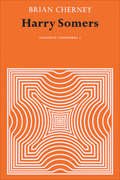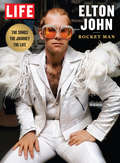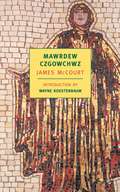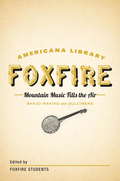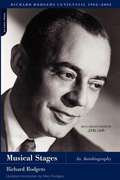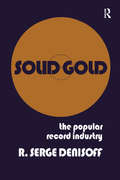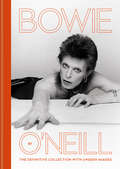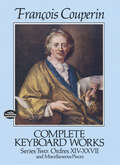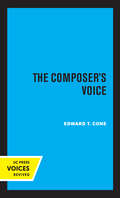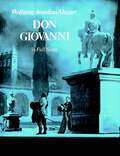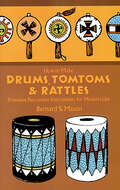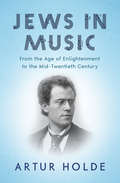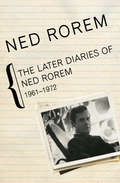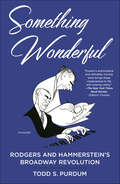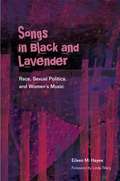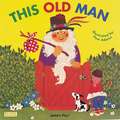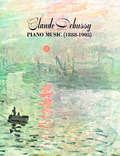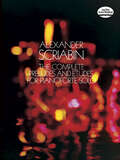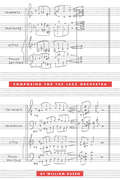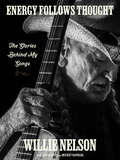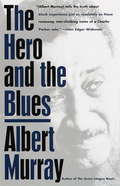- Table View
- List View
Harry Somers
by Brian CherneyHarry Somers is one of Canada's leading composers, and one of the most original. In the 1950s he experimented with contrapuntal writing, serialism, and style juxtaposition; in more recent years he has been concerned with the development of new vocal resources and improvisation. Harry Somers, a detailed study of the composer and his works, has been commissioned by the Canadian Music Centre as the first of a series, each volume of which will cover in depth the career and works of a major Canadian composer. Within the framework provided by major biographical events, Brian Cherney traces Somers' development as a composer from 1939 to 1973 by analysing works from various stages in his career. He discusses in particular the influences on Somers of Bartók, Debussy, and Weinzweig, the interrelationships between his works, and his stylistic traits and compositional techniques. A chronological list of Somers' works is included, and, because of its importance, an entire chapter is devoted to the opera Louis Riel. In view of the scarcity of in-depth critical literature on Canadian composers, this thorough and objective book will be of interest to music students, professional musicians, composers, and the general music public, both in Canada and abroad.
Mawrdew Czgowchwz: Some Divisions Of The Saga Of Mawrdew Czgowchwz, Oltrano, Authenticated By Persons Represented There
by James Mccourt Wayne KoestenbaumDiva Mawrdew Czgowchwz (pronounced "Mardu Gorgeous") bursts like the most brilliant of comets onto the international opera scene, only to confront the deadly malice and black magic of her rivals. Outrageous and uproarious, flamboyant and serious as only the most perfect frivolity can be, James McCourt's entrancing send-up of the world of opera has been a cult classic for more than a quarter-century. This comic tribute to the love of art is a triumph of art and love by a contemporary American master.
Mountain Music Fills the Air: The Foxfire Americana Libray (11) (The Foxfire Americana Library)
by Inc. Foxfire FundBanjos and dulcimers have always been an essential part of Appalachian music, shared and enjoyed throughout the generations. Here, musicians share the history of the instruments and show how they are constructed, piece by piece, with photos and diagrams.
Musical Stages: An Autobiography
by Richard RodgersRichard Rodgers was one of the most successful, prolific composers of the last century. His songs are as well known today as when he created them more than 50 years ago, for musicals such as South Pacific, Pal Joey, Carousel, the King and I, The Sound of Music and Oklahoma! At 16 he began a long working relationship with the brilliant but tormented lyricist Lorenz hart and then went on to collaborate for another 20 years with the sturdier and equally inspired Oscar Hammerstein II. Late in his extraordinary life, Rodgers wrote what has sine become a celebrated autobiography and a classic of the theatre world, Musical Stages.
Solid Gold: Popular Record Industry
by R. Serge DenisoffMore than 90 record companies release over 9,000 pop records each year-a staggering total of 52,000 songs. Each one competes for the gold record, the recording industry's symbol of success that certifies $1 million worth of records have been sold. Solid Gold explains why, for each record that succeeds, countless others fail. This book follows the progress of a record through production, marketing, and distribution, and shows how a mistake made at any point can mean its doom. Denisoff suggests that a drastic shift in the demographic makeup of the pop music audience during the sixties has resulted in a broader listening public, including fans at every level of society.
The Songs of Stephen C. Foster: from His Time to Ours
by William W. AustinWith some elements of biography of Stephen C. Foster, and his simple musical techniques, this book has a pattern that gives more emphasis to poetry, to history, and to cultural contrasts and connections during his time.
Bowie by O'Neill: The definitive collection with unseen images
by Terry O'Neill'This is not just another Bowie book. This, it's fair to say, is THE Bowie book... Essential for any fan.'THE SUNDAY TELEGRAPH'A truly sparkling collection.'THE DAILY MAIL'More than 500 photos of immense breadth and depth.'VOGUEChosen as one of Vogue's Best David Bowie Books.This book is the breathtaking result of iconic photographer Terry O'Neill's creative partnership with David Bowie that spanned over a number of years, including images published here for the first time.Containing rare and never-before-seen photographs, their work together includes images from the last Ziggy Stardust performance, recording sessions for Young Americans and the renowned studio portraits for Diamond Dogs - plus live shows, film shoots, backstage moments and more. With more than 500 photographs, this is the ultimate portrait of an inspiring, challenging and ever-changing artist.
The Bremen-Town Musicians
by Ruth Belov GrossOn their way to Bremen-town, a donkey, a cat a rooster, and a dog, all planning on a new career in music, serenade some robbers.
Complete Keyboard Works, Series Two: Ordres XIV-XXVII and Miscellaneous Pieces (Dover Classical Piano Music)
by Francois Couperin"His melodic imagination displays admirable freshness. He possesses a delicate harmonic sense. His themes show the inspirations of an impassioned musician: perfectly created, firm in line, vivid, and enduring in color. His art never wavers; it consistently exhibits a magnificent technique." -- John Gillespie, Five Centuries of Keyboard MusicThis famous edition, prepared a century ago by Johannes Brahms and Friedrich Chrysander, presents all of the 27 keyboard suites, or Ordres, by the great French composer François Couperin (1668-1733). Also included are the Allemande and 8 Preludes from Couperin's famous harpsichord treatise, L'Art de Toucher le Clavecin.In these magnificent works (there are over 200 compositions in the two volumes) lies the supreme achievement of French keyboard music, a rich source of subtle, sometimes startling, always pleasurable music for keyboard artists and students at every level of expertise. The moods, rhythms, and melodies of these distinctive compositions range across a broad musical spectrum, from crisp gavottes to noble sarabandes, from flowing allemandes to lively gigues. Some of the pieces suggest carnival merriment, others tender reflection; most have colorful and mysterious names. Couperin's virtuoso command of harpsichord style, his magnificent technique, and ever-fresh melodic imagination pervade them all.Witty, graceful, and tuneful, the keyboard works of Couperin represent a wonderful legacy of late-baroque masterpieces. Beautifully reproduced in this inexpensive edition, they make abundantly clear the justice of Bach's intense admiration for Couperin's music and the aptness of the French master's surname -- "le grand."Note: Series Two contains Ordres 14-27 plus 8 Preludes and Allemande from L'Art de Toucher le Clavecin.
The Composer's Voice (Ernest Bloch Lectures #3)
by Edward T. ConeMusic, we are often told, is a language. But if music is a language, then who is speaking? The Composer's Voice tries to answer this obvious but infrequently raised question. In so doing, it puts forward a dramatistic theory of musical expression, based on the view that every composition is a symbolic utterance involving a fundamental act of impersonation. The voice we hear is not that of the composer himself, but of a persona--a musical projection of his consciousness that experiences and communicates the events of the composition. Developing his argument by reference to numerous examples ina wide variety of styles, Mr. Cone moves from song and opera through program music to absolute instrumental music. In particular, he discusses the implications of his theory for performance. According to the dramatistic view, not only every singer but every instrumentalist as well becomes a kind of actor, assuming a role that functions both autonomously and as a component of the total musical persona. In his analysis of the problems inherent in this dual nature of the performer's job, Mr. Cone offers guidance that will prove of practical value to every performing musician. He has much to say to the listener as well. He recommends an imaginative participation in the component roles of musical work, leading to a sense of identification with the persona itself, as the path to complete musical understanding. And this approach is shown to be relevant to a number of specialized kids of listening as well--those applicable to analysis, historical scholarship, and criticism. The dance, too, is shown to depend on similar concepts. Although The Composer's Voice involves an investigation of how music functions as a form of communication, it is not primarily concerned with determine, or interpreting, the "content" of the message. A final chapter, however, puts forward a tentative explanation of musical "meaning" based on an interpretation of the art as a coalescence of symbolic utterance and symbolic gesture. While not essential to the main lines of the argument, it suggests interesting possibilities for further development of the dramatistic theory. This title is part of UC Press's Voices Revived program, which commemorates University of California Press's mission to seek out and cultivate the brightest minds and give them voice, reach, and impact. Drawing on a backlist dating to 1893, Voices Revived makes high-quality, peer-reviewed scholarship accessible once again using print-on-demand technology. This title was originally published in 1974.
Concert Piano Repertoire: A Manual of Solo Literature for Artists and Performers
by Albert FaurotListing of classical musical pieces written for the solo piano player
Don Giovanni
by Wolfgang Amadeus MozartThis is the complete orchestral and vocal score of Mozart's Don Giovanni, considered by many to be the greatest opera ever written. This edition contains all the music Mozart wrote for Don Giovanni, both for the original version performed in Prague (1787) and the alterations-Don Ottavio's aria "Dalla sua pace," Elvira's aria (and its transposition to D Major) "Mi tradì quell'alma ingrata," Zerlina and Leporello's duet "Per queste tue manine," the cut in the finale-made for the first Viennese performance six months later, as well as the concert ending of the overture.The editors, Georg Schünemann and Kurt Soldan, worked directly from Mozart's autograph manuscript and from early copies made under Mozart's supervision, correcting many errors that had persisted since Mozart's time. An extensive commentary lists all vague or controversial elements the editors encountered in the score. In addition the complete Italian libretto and stage directions by Lorenzo Da Ponte and a German translation of the vocal text by Georg Schünemann have also been included. Do not confuse this with a piano rendering; it is the full orchestral score. In addition to its obvious uses for study, this score is also an indispensable associate for anyone listening to the music. In no other manner can the listener or student keep full awareness of the many elements that make up this opera.
How to Make Drums, Tomtoms and Rattles: Primitive Percussion Instruments for Modern Use
by Bernard MasonMaking your own primitive instruments from simple materials such as coffee cans and flower pots. Includes 121 figures.
Jews in Music: From the Age of Enlightenment to the Mid-Twentieth Century
by Artur HoldeThis authoritative history chronicles the work and lives of great Jewish musicians around the world from the early nineteenth century to the mid-twentieth. Since the Age of Enlightenment, Jewish musicians, composers, and musicologists have greatly enriched the artistic legacies of cultures and countries on a global scale. Their contributions have been a major influence on numerous musical forms, both secular and sacred. Jews in Music presents a survey of these accomplishments through the rise of Zionism, the settlement of the Jewish Homeland, and the burgeoning Jewish music developments in America.Jews in Music presents a detailed history ranging from the symphonies of Felix Mendelssohn to the Broadway musicals of Leonard Bernstein, from the great touring violinists of Western Europe to the pioneers of commercial music recording. Plus, a section on sacred music explores in depth the evolution of the musical components of the synagogue, including the chants, compositions, and traditional songs of the chazzanim.
The Later Diaries of Ned Rorem, 1961–1972: 1961-1972
by Ned RoremThe esteemed American composer and unabashed diarist Ned Rorem provides a fascinating, brazenly intimate first-person account of his life and career during one of the most extraordinary decades of the twentieth century Ned Rorem is often considered an American treasure, one of the greatest contemporary composers in the US. In 1966, he revealed another side of his remarkable talent when The Paris Diary was published, and a year later, The New York Diary, both to wide critical acclaim. In The Later Diaries,Rorem continues to explore his world and his music in intimate journal form, covering the years 1961 to 1972, one of his most artistically productive decades. The Ned Rorem revealed in The Later Diaries is somewhat more mature and worldly than the young artist of the earlier works, but no less candid or daring, as he reflects on his astonishing life, loves, friendships, and rivalries during an epoch of staggering, sometimes volatile change. Writing with intelligence, insight, and honesty, he recalls time spent with some of the most famous, and infamous, artists of the era—Philip Roth, Christopher Isherwood, Tallulah Bankhead, and Edward Albee, among others—openly exploring his sexuality and his art while offering fascinating, sometimes blistering, views on the art of his contemporaries.
Liszt: The Artist as Romantic Hero
by Eleanor PerenyiBiography of the famous composer, his romantic origins, his grand and literary passions, his years of pilgrimage, his stays at Vienna and Weimar. Includes a chronology and bibliography.
Something Wonderful: Rodgers and Hammerstein's Broadway Revolution
by Todd S. PurdumA revelatory portrait of the creative partnership that transformed musical theater and provided the soundtrack to the American CenturyThey stand at the apex of the great age of songwriting, the creators of the classic Broadway musicals Oklahoma!, Carousel, South Pacific, The King and I, and The Sound of Music, whose songs have never lost their popularity or emotional power. Even before they joined forces, Richard Rodgers and Oscar Hammerstein II had written dozens of Broadway shows, but together they pioneered a new art form: the serious musical play. Their songs and dance numbers served to advance the drama and reveal character, a sharp break from the past and the template on which all future musicals would be built.Though different in personality and often emotionally distant from each other, Rodgers and Hammerstein presented an unbroken front to the world and forged much more than a songwriting team; their partnership was also one of the most profitable and powerful entertainment businesses of their era. They were cultural powerhouses whose work came to define postwar America on stage, screen, television, and radio. But they also had their failures and flops, and more than once they feared they had lost their touch.Todd S. Purdum’s portrait of these two men, their creative process, and their groundbreaking innovations will captivate lovers of musical theater, lovers of the classic American songbook, and young lovers wherever they are. He shows that what Rodgers and Hammerstein wrought was truly something wonderful.
Songs in Black and Lavender: Race, Sexual Politics, and Women's Music
by Eileen M. Hayes Linda TilleryDrawing on fieldwork conducted at eight women's music festivals, Eileen M. Hayes shows how studying these festivals--attended by predominately white lesbians--provides critical insight into the role of music and lesbian community formation. She argues that the women's music festival is a significant institutional site for the emergence of black feminist consciousness in the contemporary period. Hayes also offers sage perspectives on black women's involvement in the women's music festival scene, the ramifications of their performances as drag kings in those environments, and the challenges and joys of a black lesbian retreat based on the feminist festival model. With acuity and candor, longtime feminist activist Hayes elucidates why this music scene matters. Veteran vocalist, percussionist, producer, and cultural historian Linda Tillery provides a foreword.
This Old Man
by Pam AdamsTen old men in colorful outfits are featured with the text of this traditional counting song. Each illustration features a die-cut through which the next old man can be seen. Picture descriptions and math formulas present.
Claude Debussy Piano Music 1888-1905
by Claude DebussyThis volume contains the complete music for solo piano written by Claude Debussy between 1888 and 1905. Beginning with Deux Arabesques (1888), it offers the Suite bergamasque (1890-1905), Réverie (1890), Danse (1890), Ballade (1890), Pour le piano (1896-1901), D'un cahier d'esquisses (1903), Extampes (1903), Mazurka (1891), Valse romantique (1890), Masques (1904), L'Isle joyeuse (1904), and the first series of Images (1905): Reflets dans l'eau, Hommage a Rameau, and Mouvement. In each case the music has been reproduced photographically from original or early editions. This book has been designed to be used at the piano. Noteheads are large and clearly printed: margins and spaces are adequate for written notes, fingerings, and turnovers. It is also most useful, of course, for analysis or simply for listening along with the music.
The Complete Preludes and Etudes for Pianoforte Solo (Dover Classical Piano Music)
by Alexander ScriabinAlexander Nikolayevitch Scriabin (1872-1915), Russian composer and pianist, is best known for his perfectly spun miniatures where his novel harmonic and pianistic ideas were most brilliantly worked out. This volume in Dover's continuing series of musical scores presents the best of Scriabin's works, his complete etudes and preludes for the solo piano. There are the Chopinesque works from his early period, including the 12 etudes from Op. 8 and the 24 Preludes, Op. 11. The works of the middle period, when he began working out his new harmonies based on a series of fourths, include the outstanding sets of Preludes, Opp. 33 and 48, and the Etudes, Op. 42. The 5 Preludes, Op. 74, and the Etudes, Op. 65, from the final period reveal perhaps most about his joyous ecstasy and languid contemplation, moods which no other composer could express to such a degree. There are also the preludes and etudes from Opp. 2, 9, 13, 15, 16, 17, 22, 27, 31, 35, 37, 39, 45, 49, 51, 59, and 67, each containing miniatures working out some subtle harmonic, rhythmic, or melodic idea with a perfect pianistic sense of writing. This book has been especially designed as a playing edition - the noteheads are large and easily readable at the piano, and the margins and spaces between staves are adequate for written notes, fingerings, and turnovers. It is also most useful for analysis, or simply for following along with the actual music.
Composing for the Jazz Orchestra
by William Russo"Although it will be of primary interest to those who are engaged in composition themselves, [this] book is also recommended for readers who may wish to gain further insight into just what makes jazz composition so different from traditional approaches."—Malcolm Bessom, The Music Magazine
Energy Follows Thought: The Stories Behind My Songs
by Willie Nelson David Ritz Mickey RaphaelRevealing, funny, whimsical, and wise, outlaw country legend Willie Nelson shares the untold stories behind the his favorite songs, with all the lyrics and a dynamic assortment of never-before-seen photos and ephemera.From his earliest work in the 1950s to today, Willie looks back at the songs that have defined his career, from his days of earning $50 each to his biggest hits, from his less well-known songs (but incredibly meaningful to him) to his concept albums. Along the way, he also shares the stories of his guitar Trigger, his family and “family,” as well as the artists he collaborated with, including Patsy Cline, Waylon Jennings, Ray Charles, Merle Haggard, Ray Price, Dolly Parton, and many others.Willie is disarmingly honest—what do you have to lose when you’re about to turn 90? —meditating on the nature of songwriting and finding his voice, and the themes he’s explored his whole life—relationships, infidelity, love, loss, friendship, and, of course, life on the road.
The Hero And the Blues
by Albert MurrayIn this visionary book, the author of the legendary Stomping the Blues takes an audacious new look at black music and, in the process, succeeds in changing the way we read all literature. Albert Murray's subject is the previously unacknowledged kinship between fiction and the blues. Both, he argues, are virtuoso performances that impart information, wisdom, and moral guidance to their audiences. Both place a high value on improvisation. And both fiction and the blues create a delicate balance between the holy and the obscene, essential human values and cosmic absurdity. Encompassing artists from Ernest Hemingway to Duke Ellington, and from Thomas Mann to Richard Wright, The Hero and the Blues is at once an homage and a manifesto for a new black aesthetic. Erudite, eloquent, appreciative, and iconoclastic, it is further evidence of Murray's ability to turn the essay into a kind of poetry -- as enchanting as it is instructive.
